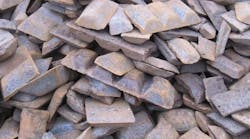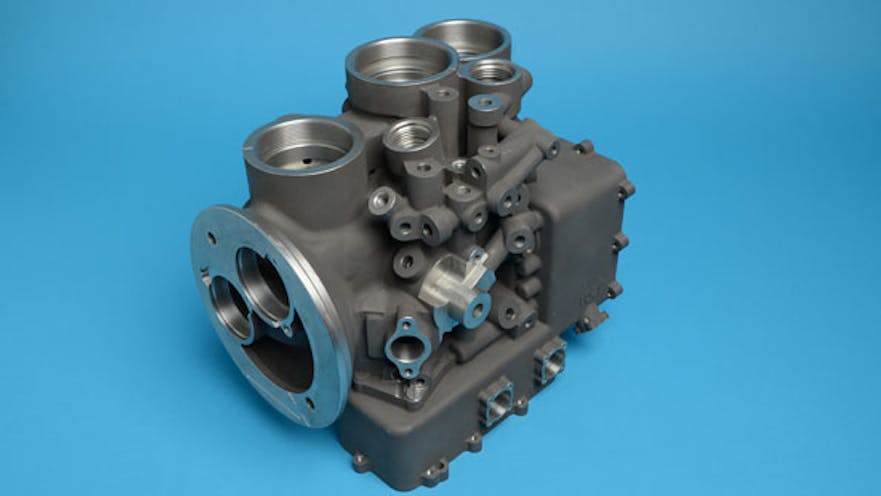If you're one of those who clings to the notion that investment casting is over-rated, have a closer look: each of the castings that earned recognition in this year's Investment Casting Institute 2012 Industrial Casting Award competition exhibit all the attributes and advantages that have earned so much attention and success for the foundries that excel at the process.
First, there is design flexibility: investment casters achieve shapes and dimensions that other processes cannot (yet) achieve with consistency. Next, there are savings in production processes; investment castings routinely reduce or eliminate the time and cost of finish machining.
Above all, there is the customer satisfaction: product designers and OEMs trust investment casting to return to them the component they conceived in their CAD programs — a component that conforms to their imagination. Frequently, it's a part that replaces numerous other pieces and assemblies, adding mass-reduction to the other advantages.
ICI announced this year's winning designs at its recent annual meeting. The yearly casting contest is open to ICI member companies, and recognizes organizations that manufacture components that illustrate and promote the benefits and flexibility of the investment casting process, or which demonstrate problem solving techniques for the customer.
Two awards were presented for "military castings": Shellcast Inc., Montague, MI, developed a casting that illustrates the design flexibility available via investment casting. This component incorporates a unitary design that achieves compactness and yet structural integrity for a high-pressure application. It is a stainless steel casting for a hydraulic pump valve component, with a cast attenuator chamber sphere. Its internal passages are achieved using soluble cores that require ceramic formation inside by straight-dipping procedures though narrow inlet areas. Inner chamber coating and drying are accomplished by a combination of ceramic layering and moisture management techniques. The cast sphere wall is inspected via ultrasonic techniques, and post-cast cooling controls, as well as hot-isostatic pressing, ensure high density. Shellcast has cast over 300 of these components, which are part of an active-production military aircraft program, and it conducts an inventory-stocking program with the customer.
Another award for a military casting was presented to Uni-Cast Inc., Londonderry, NH. It is a 24×22×16-in., cast-aluminum electronic housing sensor designed to reduce production cost over a fabricated assembly of numerous machined components. Its near-net-shape configuration minimizes machining, and the thin-walled construction with finning provides excellent heat dissipation. It is a one-piece construction with three, integral net-shape card guide bays. The staggered-fin design allows taller fins to be spaced close together, to increase heat transfer.
The award for an "industrial" casting went to Aristo-Cast Inc., Almont, MI. This main valve body of a two-stage converter for LP-gas engines is a 4.7×4.5×1.25-in. aluminum casting with multiple features cast-in to eliminate machining steps. Aristo-Cast reverse-engineered the part to create a solid model file of the tool design using 3D Systems' Thermo Jet machines to produce wax patterns of the tool and all the core pins. The combination of prototype and tool-building skills cut delivery time by several weeks.
Alcoa Cast Products in Georgetown, ON, earned the award for an "aerospace" casting. The 11×10×8-in. aluminum part is a fuel-metering unit with six intricate cores that range from 3 to 12 in. long, with 0.6- to 1.5-in. diameters.
In addition to these winning designs, five other entries were recognized as finalists. These castings were presented by Barron Industries, Oxford, MI; Kovatch Castings, Uniontown, OH; O'Fallon Casting, O'Fallon, MO; TPM Inc., Sugar Land, TX; and Uni-Cast/Cera-met, Bethlehem, PA.
"Just looking at some of these castings is enough to show what can be done with investment casting. Each internal passage, intricate coring detail, thin wall, and each difficult design element represents an advantage of the investment casting process and a potential problem solved for the customer," offered ICI executive director Michael Perry. "The use of investment casting can often result in total cost savings, because of reduced machining and finishing, combining part details into a one-piece casting, or improving surface finish."









